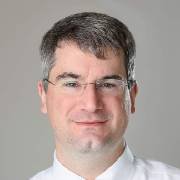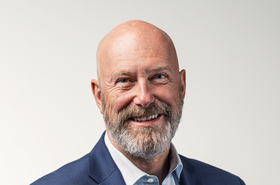Google's Director of Global Energy & Location Services Raiford Smith sat down for a Q&A with DCD's Rebecca Davison to share his experience scaling Google's data centers with 100% renewable energy and working towards their long-term commitment of carbon-free energy on a 24/7 basis, while also forging the way for other companies to build and operate sustainable data centers.
Q: Raiford, you have extensive experience in the energy sector and coming from other sectors. How unique is the data center industry in terms of the sustainability challenges it faces? What strategies have you been able to implement from other industries?
A: The data center industry is exploding right now as a result of increasing customer demand as more and more organizations across all industries transition to the cloud. In order to address customer demand, more and more data centers will need to be built, driving the need for clean energy. While Google has used 100% renewable energy since 2017 and been carbon neutral since 2007, expansion of cloud provider data center fleets will drive the need for new innovations to ensure they continue to reduce carbon emissions, rather than drive them up.
At Google, we’ve designed all of our data centers to be energy efficient - from the ground up, from day one. The teams designing our data centers are constantly seeking new and innovative ways to build our sites and design the technology that powers them.
Our teams have leveraged the environment around them to limit the environmental impact of the data center in a variety of ways. First, we’ve repurposed old industrial sites, from aluminum smelter sites in Oregon and South Carolina and a shuttered paper mill in Finland. Additionally, we lead the industry in pioneering hyperefficient design innovations, like using machine learning to reduce and optimize overhead power consumption, and cooling our data centers with rainwater in South Carolina, recycled wastewater in Georgia, and canal water in Belgium.
Watch the latest sustainability webinars on-demand
Q: As the largest corporate buyer of renewable energy in the world, in your view, how has your relationship with power utilities influenced the wider industry? What could other markets who have higher barriers or less experience learn from your achievement?
A: Google’s thoughtful approach to sourcing renewable energy around the world has proved the viability of new kinds of partnerships, policies, and deal types, and created new clean energy pathways for other organizations. By working with power utilities and markets around the world – our engagement and policy work can help open new markets for carbon-free renewable energy and empower consumers to choose their electricity supply.
A great example of markets benefiting from our dedication to helping companies and regions around the world source renewable energy is our recent deal in Taiwan. In 2019, we finalized a landmark agreement to purchase the output of a forthcoming 10-megawatt solar farm in Tainan City, Taiwan. The solar purchase agreement provides a long-term and fixed electricity price to support our operations in Taiwan, and it will also boost the carbon-free profile of our local data center. Standing 40,000 solar panels strong, our project in Taiwan will be located 100 kilometers south of our Changhua County data center and connected to the same regional power grid. This deal was made possible by discussions between Google, other companies, and the Taiwanese government -- which recently amended the country’s Electricity Act to allow non-utility companies to directly buy renewable energy and decrease their carbon footprints.
Google knows addressing climate change will require rapidly decarbonizing every electric grid on the planet. Through our efforts, the company is dedicated to making it simple for any business, anywhere in the world to purchase and use renewable energy. We’re only at the beginning of this journey, too. From becoming carbon-free, to achieving 100 percent renewable energy for two years in a row, to working towards our long-term commitment of powering all operations with carbon free energy on a 24x7 basis, there is so much more for Google as a company, as well as the broader industry, to learn and achieve in this space.
Q: What trends do you think hold more potential in disrupting the traditional model of energy procurement by data centers and what are the main hurdles?
A: Historically, Google, like most non-utility energy buyers, has sourced renewable energy (RE) to match our energy consumption by issuing one-off Requests for Proposals (“RFPs”), specific to individual regions. These bespoke RFPs, as well as the contracting and negotiation phase that follows, are complex to develop, manage, and evaluate. They also impact local grids and can create constraints on the transmission system. To buy our largest-ever tranche of RE, we simplified a large part of our procurement by running timed, reverse auctions in four global electricity markets. This is the first time Google has carried out a set of RE auctions, and it’s rare for non-energy companies to run such auctions. This helped simplify the contracting and enabled us to meet our 100% RE target yet again.
Additionally, close alignment among various stakeholders is key to achieving these results. Forming deep relationships with local PUCs to jointly develop solutions and manage new loads coming onto the grid will be critical. This way, one can manage partnerships to ensure both parties see eye to eye and achieve mutually-beneficial outcomes.
Q: It’s been reported that you will be building a second data center in Hamina, Finland. How do you see your relationship in the region shaping the future digital and energy infrastructure? Are there any untapped markets coming to the fore?
A: Our data center in Finland is a prime example of the innovations we are constantly working towards in order to achieve our long-term goal of powering all operations with clean energy 24x7. For example, our current data center in Finland’s electricity consumption is one of the model performers on carbon-free energy around the clock.
In 2017, 97% of the data center’s electricity consumption was matched on an hourly basis with carbon-free sources. We were able to achieve this because first, Google has been able to sign multiple wind energy PPAs in the region and second, Finland’s power grid has an abundance of other carbon-free energy sources like nuclear (the country’s largest source of electricity production), hydropower, and biomass. Indeed, we find that nuclear and hydro are important sources of carbonfree energy at several of our data centers.
Q: In terms of achieving overall sustainability, how is your leadership position changing beyond renewable energy?
A: Google knows organizations can no longer ignore the social, political, and meteorological changes going on around us. Companies have to manage their finances while looking for new sources of energy and operate on renewable, clean energy whenever possible. Companies large and small, utilities, regulators, and developers need to work together to achieve a carbon-free future. Google has pioneered sustainable operations by matching 100% of the electricity consumption of our operations with purchases of renewable energy, working to reduce our total energy consumption by pursuing aggressive energy efficiency initiatives, as well as buying carbon offsets for any remaining emissions we haven’t yet eliminated.
Furthermore, we are constantly working towards our long-term goal of powering all operations with clean energy, 24x7. For example, we have partnered with companies like DeepMind to develop solutions to derive data and insights into how ML can predict wind to power our data centers, and we have worked with local communities and governments in regions across the globe to make it easier to purchase or procure clean energy, among many other initiatives. We hope to serve as a model for other companies and want others to learn from the ways we are going about addressing the issue of demand and supply optimization in order to get closer to achieving this goal.
For the latest on sustainable operations and best-practice, tune in to DCD>Towards Net-Zero, the global virtual summit on data center decarbonization.




